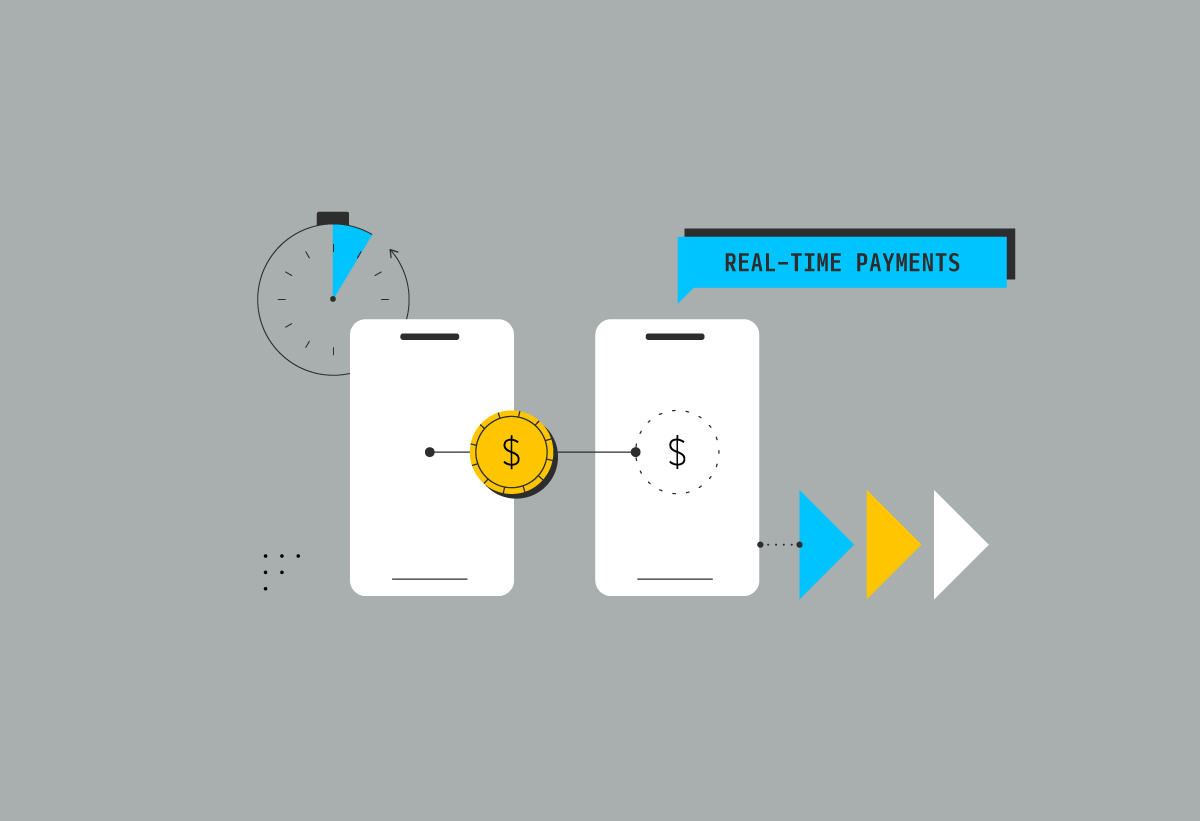Blog
What are real-time payments, and how important are they for merchants?
June 1, 2023
Editorial Team

Real time payments networks (RTP) offer a fast, efficient way of transferring funds between individuals and businesses. However, while they have a number of benefits — in particular, speed — they come with their own challenges and are not advantageous for all use cases at present. While open banking can help facilitate real time payments, it isn't necessary.
In this article, we will look at some of the benefits of a real time payments network, the state of RTP around the world, and what other considerations merchants should keep in mind.
Defining real-time payments
Online payments can appear to be almost instantaneous. But while banks and some payment providers have made payments appear to be real-time because they provide funds to the recipient even before the payments settle, the US does not operate in a world of instant payments. In fact, due in part to resistance from big banks, for consumer-to-business (C2B) payments, it can take days or weeks for funds to post and settle in merchants’ bank accounts.
By contrast, in many other parts of the world, real time payments — electronic payments that are processed in real time 24/7/365 — are relatively common. This means that a payer can send money to a payee, anywhere, at any time, and they will receive it almost immediately, including public holidays.
How real-time payments work
With real-time payments, a customer initiates a payment via a mobile app or online banking platform, and the funds are transferred instantly into the recipient's account. The entire process typically takes only a few seconds, which is significantly faster than traditional payment methods, such as credit cards or Automated Clearing House (ACH) payments.
What separates RTP from other payment methods is its two-way communication between payer and payee. With other payment methods, payment details only flow one way: from payer to payee. As communication often takes place outside of the payment system in order for settlement to occur, this means there will always be a time delay. By contrast, bidirectional communication enables both the payer to its bank and from its bank to the payee’s bank to communicate with one another, removing that time lag.
Real-time payments networks around the world
In the US, the most prominent example of a real-time payments network is The Clearing House’s RTP network. FedNow, the Federal Reserve’s anticipated real-time payments modernization solution, will also be a real-time network. The Federal Reserve is planning to launch FedNow in 2023.
Other real-time payment networks around the world include Faster Payments Service in the UK, SEPA Instant Credit Transfer in the EU, Pix in Brazil, New Payments Platform in Australia, and UPI in India. Some of these — in particular Pix and UPI — are seeing breakneck adoption, demonstrating a global trend towards real-time payments.
Where real-time payments are beneficial
Real-time payments bypass card networks, which slow down the payment process. This makes them faster, more efficient, and more secure than traditional payment methods.
For businesses, a real time payments platform can offer more efficient cash flow management by providing immediate access to funds. This can help them better manage working capital and improve their overall financial performance. Further, speed is particularly useful for businesses that need to pay suppliers or vendors quickly. This can help to improve business relationships and ensure that goods and services are delivered on time.
Reduced (certain types of) payment fraud
Another key advantage of real-time payment methods over traditional methods such as credit cards is reduced fraud, since no card details need to be input, and security features, such as two-factor authentication, can help to prevent fraudulent activities.
Furthermore, they provide businesses with greater visibility and control over their payment processes. They can monitor transactions in real time and quickly identify any suspicious activity, which can help to resolve errors, prevent fraud and minimize losses.
Real-time payments challenges and risks
Real-time payments have a number of clear benefits and — it could be argued — represent a global secular trend. But they do come with some risks and challenges. Moreover, on a market-by-market basis, the picture is more complex than what the speed of adoption in India and Brazil may show.
The benefits for customers are not clear
If you’re a customer, your card, wallet, or even bank account appear to have funds removed instantly when you make a payment, meaning that there is little advantage to you in terms of whether a payment is real time or not. Further, if you order something that doesn’t arrive or is damaged on arrival, or you are charged an incorrect amount, you do not necessarily have the option to make a chargeback. This lack of a compelling advantage may make customers as a whole reluctant to adopt a new, unfamiliar payment method unless it is mandated by regulatory authorities, as is the case in Brazil and India with Pix and UPI.
Potential errors
The fact that real-time payments are settled instantly can be both a positive and a negative. The instant settlement leaves mean there’s no time to correct any errors that may have been made in payments after they are sent. This means extra vigilance is required and that mistakes can be tedious and time-consuming to correct.
Increased risk of false positives, and potentially more complexity in managing fraud
With regular card payments, fraud detection actually has a relatively long window of time in which it can be identified, since the delay between the payment being initiated and settled gives an opportunity to flag suspicious transactions. By contrast, with RTP, once the payment is initiated there is no room to flag it. Therefore, all fraud detection efforts need to be focused on before the transaction takes place, which requires a greater volume of data.
Depending on the merchant and size of your average transaction value, merchants may also want to be conservative in their approach, for example, a merchant selling expensive jewelry may take an extra conservative approach to fraud management to avoid losing costly merchandise. However, this runs the risk of creating false positives — transactions that are blocked because they look fraudulent but actually aren’t, which can cost valuable business.
So while committing fraud is more difficult, since RTP payments are initiated by the payer in their bank environment, protecting against fraud while keeping false positives low is also more complex.
In the US, The Clearing House is limited in its reach, and FedNow will take years to hit critical mass
And in the US, there are a couple of other limited factors. Again, unlike Brazil, India, or many other markets, the lack of federal mandates to brute-force all banks to open access to accounts means that many customers can not make real-time payments with The Clearing House or FedNow even if they want to. For example, for The Clearing House's RTP network, only 300 banks are integrated, of 4,000 in the market, reaching only just over 60% of checking accounts in the US.
Regarding FedNow and RTP, transactions will only work between participating banks, and widespread adoption may take years both from a customer and bank perspective. Furthermore, it is currently set up for push payments, so subscriptions and other autopay features won’t work. FedNow and RTP will not offer any type of payment reversal or chargeback functionality. At the moment, both FedNow and RTP are not authorized for e-e-commerce payments and are therefore better suited for B2B or P2P payments rather than C2B payments.
Real-time payments are coming, but in the meantime, here's what to do
For people buying online, the most successful payment methods are often a simple button to click at checkout. For businesses, on the other hand, it is a little more complex. Conversion (i.e. making the checkout experience as easy and intuitive as possible), is particularly critical. Risk management — in particular managing fraud and ensuring it is as low as possible, while not blocking any transactions that look fraudulent but aren’t is also important. And speed is important too. Funds should be settled in in a timely manner, although that doesn't necessarily mean instantly.
Given these criteria, are real-time payments an important part of the payment mix for US merchants today?
Realistically, for businesses that sell to customers online, they are not yet critical, due to the issues with customer experience, adoption, and reach outlined above.
Instead, merchants can look for payment methods that address their key concerns around conversion, fraud management, and speed, and leverage these advantages to accelerate growth.
Introducing Link Money - Pay by Bank
What you can do today, with proven technology, is adopt a payment method that meets the criteria above and a partner that will work with you to ensure you get payments settled in a timely manner.
Today, payment technology providers such as Link Money have built that seamless payment experience for your buyers, and work with our customers to settle payouts at a speed that is consistent with consumer demand and their immediate payment needs.
For example, as Link Money - Pay by bank runs on ACH payment rails, we can arrange same-day ACH settlement, or faster or slower settlement as needed. And as other payment rail innovations such as FedNow become more widely adopted, we will continue to
Furthermore, for merchants, using Link Money costs around 70% less on average than a credit card transaction, and comes with extra features such as smart retries to ensure payments have the maximum chance of success, and verification to ensure that your customers are connecting real bank accounts.
To find out more, contact us.